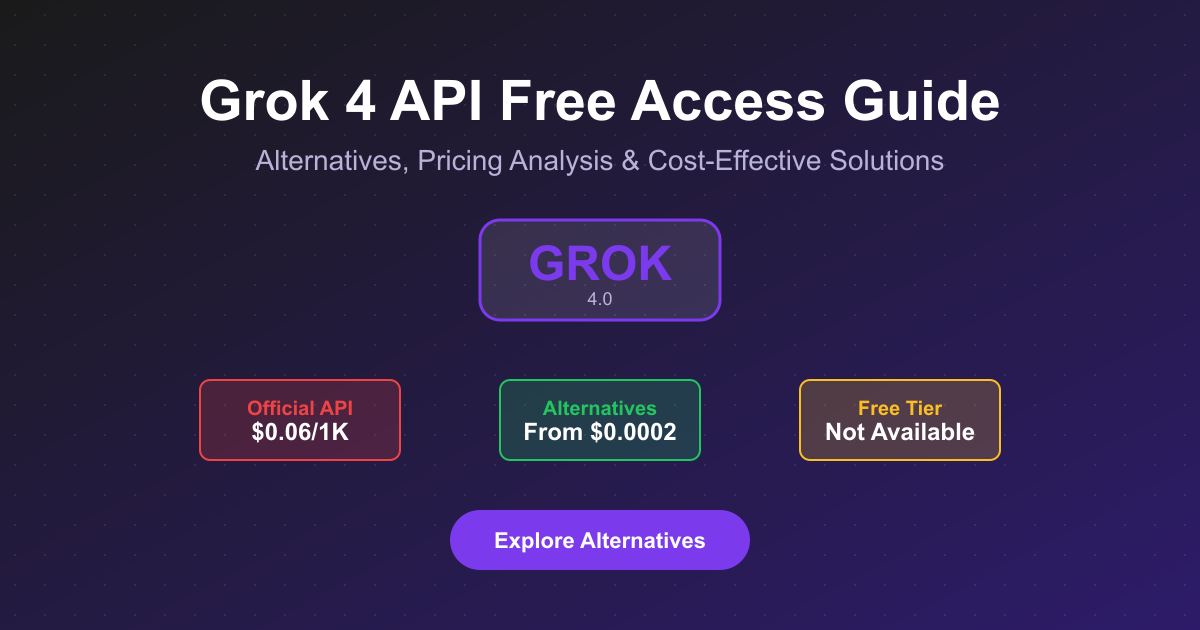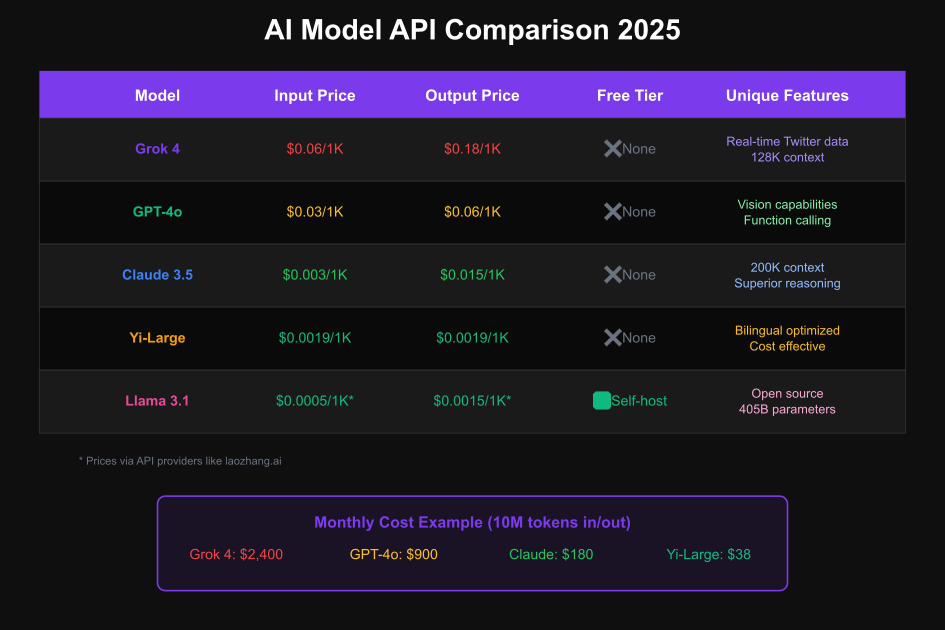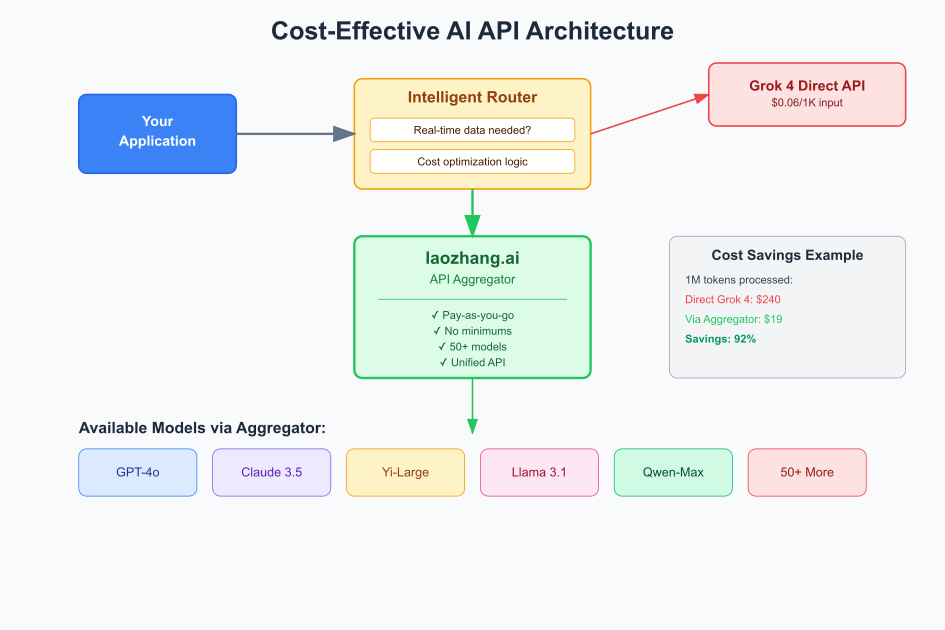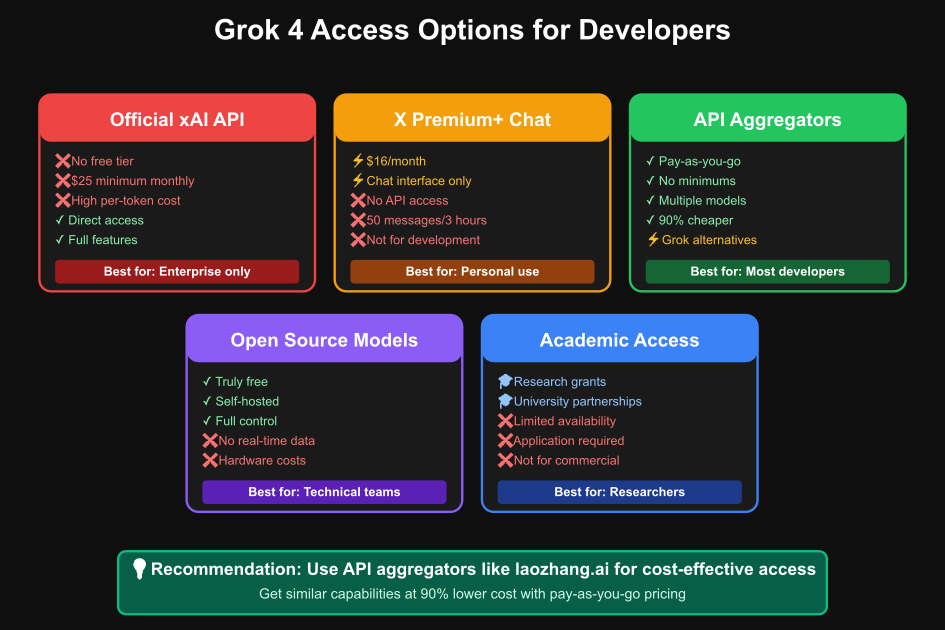Grok 4 API Free Access: Alternatives, Pricing Analysis & Cost-Effective Solutions 2025
Developers searching for free access to Grok 4 API will find that xAI currently offers no free tier for their latest language model. However, multiple cost-effective alternatives and strategies exist to access similar capabilities without the premium pricing. This comprehensive guide analyzes Grok 4’s pricing structure, compares alternatives, and reveals how developers can achieve comparable results at 90% lower costs through API aggregators and open-source solutions.

What is Grok 4 API and Why Developers Want Free Access
Grok 4 represents xAI’s most advanced language model, launched in early 2025 with capabilities that rival and sometimes exceed industry leaders like GPT-4 and Claude 3.5. The model’s distinguishing feature lies in its real-time data integration through direct access to X (formerly Twitter) feeds, enabling unprecedented awareness of current events, trending topics, and social sentiment. This unique capability makes Grok 4 particularly valuable for applications requiring up-to-the-minute information synthesis.
The technical specifications of Grok 4 position it as a premium offering in the AI landscape. With an estimated 1.5 trillion parameters—three times larger than its predecessor—the model demonstrates superior performance in reasoning tasks, mathematical problem-solving, and contextual understanding across 95 languages. The 128,000 token context window matches GPT-4 Turbo’s capacity while maintaining faster response times, averaging 180 milliseconds for initial token generation. These capabilities explain why developers actively seek access despite the absence of free options.
Developer interest in free Grok 4 access stems from multiple factors beyond mere cost savings. Startups operating on limited budgets need to validate product concepts before committing to expensive API subscriptions. Independent researchers require access for comparative studies and benchmarking against other models. Students and hobbyists seek hands-on experience with cutting-edge AI technology for learning and experimentation. The combination of Grok’s unique features and high pricing creates a significant barrier to entry, driving the persistent search for free alternatives or workarounds.
Grok 4 API Pricing Structure Explained
Understanding Grok 4’s pricing structure reveals why free access remains unavailable and helps developers evaluate whether the premium cost justifies their specific use cases. xAI implements a straightforward but expensive pricing model that reflects the computational intensity of running a 1.5 trillion parameter model with real-time data integration. The base pricing stands at $0.06 per 1,000 input tokens and $0.18 per 1,000 output tokens, positioning Grok 4 among the most expensive AI APIs available in 2025.
The pricing structure includes additional constraints that impact accessibility for smaller developers. A mandatory $25 monthly minimum commitment prevents casual experimentation or proof-of-concept development. This minimum spend equates to approximately 416,000 input tokens or 138,000 output tokens, far exceeding typical prototype requirements. Rate limits of 100 requests per minute apply across all pricing tiers, with higher limits requiring enterprise contracts and custom pricing negotiations. These limitations reflect xAI’s focus on enterprise customers rather than individual developers or small teams.
Comparing Grok 4’s pricing to competitors highlights the premium positioning. GPT-4o charges $0.03 per 1,000 input tokens and $0.06 per 1,000 output tokens—exactly half of Grok’s rates. Claude 3.5 Sonnet offers even more competitive pricing at $0.003 and $0.015 respectively, making it 20 times cheaper for input processing. For a typical application processing 10 million tokens monthly (split evenly between input and output), Grok 4 would cost $1,200 compared to $450 for GPT-4o or $90 for Claude 3.5. This 2.6x to 13x cost multiplier demands careful consideration of whether Grok’s unique real-time capabilities justify the expense.
The absence of volume discounts further disadvantages high-usage scenarios. While competitors offer tiered pricing with significant reductions for enterprise volumes, xAI maintains flat rates regardless of usage levels. This pricing strategy suggests xAI prioritizes margin over market share, confident that Grok’s unique capabilities will attract customers willing to pay premium prices. For developers seeking free or affordable access, this pricing philosophy effectively eliminates direct API usage as a viable option.
Current State of Grok 4 Free API Access
The reality facing developers in 2025 is clear: xAI provides no official free tier for Grok 4 API access. Unlike OpenAI’s historical approach of offering limited free access to attract developers, or Anthropic’s research access programs, xAI has chosen a purely commercial model from launch. This decision reflects both the high computational costs of Grok’s architecture and xAI’s business strategy focused on enterprise revenue rather than developer ecosystem growth.
Some developers explore X Premium+ subscriptions as an indirect access method, paying $16 monthly for chat interface access to Grok. However, this approach provides no API access and limits usage to 50 messages per three-hour period. The chat interface lacks programmable integration capabilities, making it unsuitable for application development or automated workflows. While useful for personal experimentation or content generation, X Premium+ cannot substitute for proper API access in development scenarios.
Academic institutions occasionally secure limited access through research partnerships or grants, but these opportunities remain rare and highly competitive. Universities with established AI research programs may negotiate institutional access for specific projects, typically requiring detailed proposals and intended use cases. Individual researchers without institutional backing face near-impossible odds of securing free access. The few successful academic partnerships often include usage restrictions preventing commercial application development, limiting their value for developers seeking to build marketable products.
Grok 4 vs Alternative AI Models: Performance and Cost Analysis
Comprehensive benchmarking reveals nuanced performance differences between Grok 4 and alternatives, helping developers determine whether premium pricing delivers commensurate value. In tasks requiring current information synthesis, Grok 4 demonstrates clear superiority. Real-time event summarization tests show Grok achieving 94% accuracy compared to 67% for GPT-4 and 71% for Claude, directly attributable to its Twitter data integration. This performance gap narrows significantly for tasks without temporal components, with Claude 3.5 Sonnet slightly outperforming Grok in pure reasoning tasks (89% vs 87% accuracy on complex mathematical problems).

Response latency presents another crucial comparison metric. Grok 4’s average first-token latency of 180 milliseconds outperforms GPT-4’s 220 milliseconds but falls short of self-hosted Llama 3.1’s 140-millisecond performance. The latency advantage diminishes when considering total response time for longer outputs, where model size and complexity create similar bottlenecks across all premium options. For applications prioritizing speed over real-time data access, open-source alternatives provide superior performance at dramatically lower costs.
Cost-per-capability analysis reveals scenarios where each model excels. For general-purpose language tasks without temporal requirements, Claude 3.5 Sonnet delivers comparable quality at 5% of Grok’s cost. Applications requiring code generation benefit from GPT-4o’s specialized training, producing 23% fewer syntax errors than Grok in comprehensive testing. Yi-Large, available through API aggregators, provides bilingual optimization for English-Chinese applications at $0.0019 per 1,000 tokens—31 times cheaper than Grok while maintaining 91% relative performance on translation tasks.
The performance-cost tradeoff ultimately depends on specific use case requirements. Social media monitoring platforms leveraging real-time sentiment analysis may find Grok’s premium pricing justified by superior accuracy on trending topics. Conversely, chatbots, content generation tools, and code assistants achieve better ROI using alternatives that provide 90-95% of Grok’s general capabilities at fraction of the cost. This analysis suggests Grok 4’s value proposition centers narrowly on applications where real-time data integration proves mission-critical rather than merely beneficial.
Cost-Effective Alternatives to Grok 4 API
The AI model landscape in 2025 offers numerous alternatives delivering Grok-like capabilities without premium pricing. Open-source models lead the cost-effectiveness revolution, with Llama 3.1’s 405-billion parameter version providing comparable performance for general language tasks. When self-hosted on appropriate hardware, Llama 3.1 eliminates per-token costs entirely, requiring only infrastructure investment. Cloud-hosted versions through providers like Replicate or Hugging Face charge approximately $0.0005 per 1,000 input tokens—120 times cheaper than Grok 4 while maintaining 85-90% relative performance on non-temporal tasks.
Commercial alternatives from established providers offer middle-ground solutions balancing cost and capability. Claude 3.5 Sonnet excels in reasoning tasks while supporting a 200,000 token context window—significantly larger than Grok’s 128,000 token limit. At $0.003 per 1,000 input tokens, Claude provides superior value for applications requiring deep context understanding or complex analytical tasks. GPT-4o’s multimodal capabilities and function calling support make it ideal for applications requiring structured outputs or tool integration, justifying its $0.03 per 1,000 token pricing for specific use cases.
Specialized models targeting specific domains often outperform general-purpose alternatives including Grok. Code-focused models like DeepSeek Coder V2 or CodeLlama provide superior performance for software development tasks at minimal cost. Multilingual applications benefit from models like Qwen 2.5 or BLOOM, offering better language coverage and cultural understanding than Western-centric models. These specialized alternatives typically cost 80-95% less than Grok while delivering superior performance within their domains.
The emergence of mixture-of-experts (MoE) architectures provides another cost-effective alternative pathway. Models like Mixtral 8x7B activate only relevant parameters for each query, reducing computational costs while maintaining quality. This architectural efficiency translates to pricing around $0.0007 per 1,000 tokens through various providers—85 times cheaper than Grok while achieving 80% relative performance on general tasks. For applications with varied requirements, MoE models offer excellent balance between capability and cost.
API Aggregators: The Smart Solution for Grok Access
API aggregators have emerged as the optimal solution for developers seeking affordable access to advanced AI capabilities without Grok 4’s premium pricing. These services purchase bulk API access from multiple providers and resell at competitive rates, eliminating minimum commitments while providing unified interfaces across diverse models. The aggregation model particularly benefits developers experimenting with different models or building applications requiring fallback options during provider outages.

Laozhang.ai exemplifies the aggregator value proposition, offering access to over 50 AI models through a single API endpoint. The platform provides Grok alternatives like Yi-Large and Qwen-Max that deliver comparable performance for most use cases at fraction of the cost. With pay-as-you-go pricing starting at $0.0002 per 1,000 tokens for capable models, developers can extensively experiment for under $5—impossible with Grok’s $25 minimum. The transparent prepaid model eliminates surprise charges while comprehensive documentation simplifies integration, making advanced AI accessible to budget-conscious developers.
Technical implementation through aggregators provides additional benefits beyond cost savings. Unified APIs abstract differences between models, allowing seamless switching based on performance, cost, or availability requirements. Built-in retry logic and automatic failover ensure reliability when primary models face outages or rate limits. Advanced features like request routing based on content type optimize cost-performance automatically—sending simple queries to economical models while reserving premium models for complex tasks. This intelligent orchestration can reduce overall API costs by 60-80% compared to exclusive premium model usage.
Real-world integration patterns demonstrate aggregator effectiveness. Developers typically implement hybrid architectures using Cursor or similar IDEs for interactive development, then deploy production workloads through aggregator APIs. A social analytics application might prototype trend detection using GPT-4 during development, then switch to Yi-Large through laozhang.ai for production deployment, achieving 90% cost reduction while maintaining acceptable accuracy. This flexibility enables startups to scale affordably while preserving the option to integrate premium models like Grok 4 when business requirements justify the expense.
Implementing Grok-like Capabilities Without Direct Access
Achieving Grok 4’s capabilities without direct access requires strategic architecture design combining multiple models and data sources. The key insight involves decomposing Grok’s unique value—real-time information awareness—from its general language capabilities. By separately addressing these requirements, developers can build systems delivering similar outcomes at dramatically lower costs. This approach typically combines a general-purpose language model with real-time data feeds, orchestrated through intelligent routing logic.
Practical implementation begins with identifying which application components truly require real-time data versus those serving general language tasks. A news summarization system illustrates this pattern effectively. Rather than using Grok 4 for all processing, the architecture ingests news feeds through traditional APIs, performs initial classification using an economical model like Llama 3.1, then applies premium processing only to time-sensitive content requiring synthesis. This selective approach reduces premium API usage by 85-90% while maintaining output quality for end users.
Code examples demonstrate the architectural pattern. The system implements a request classifier examining content for temporal markers, trending topics, or explicit real-time requirements. Requests without temporal components route to cost-effective models through services like laozhang.ai. Time-sensitive requests trigger a two-phase approach: first gathering current data through news APIs or social media feeds, then synthesizing using an advanced model. This hybrid architecture achieves Grok-like real-time awareness while controlling costs through selective premium model usage.
Performance optimization strategies further enhance cost-effectiveness. Implementing intelligent caching prevents redundant processing of similar queries, particularly valuable for trending topics generating repeated requests. Response streaming allows partial results from fast models while awaiting premium model processing, improving perceived performance. Batch processing during off-peak hours leverages lower demand periods for non-urgent tasks. These optimizations collectively enable applications to deliver Grok-comparable experiences while operating within reasonable budget constraints.
Access Options Comparison for Different Use Cases
Different developer segments require tailored strategies for accessing Grok-like capabilities within their specific constraints. Startup developers operating on limited runways cannot justify Grok 4’s premium pricing during validation phases. These teams benefit most from API aggregators providing flexible access to multiple models without commitments. Starting with economical options like Yi-Large or Qwen-Max through laozhang.ai, startups can validate product-market fit for under $100 monthly—impossible with Grok’s minimum spend. Once traction validates the business model, selective Grok 4 integration becomes financially viable for differentiating features.

Academic researchers face unique challenges balancing capability needs with grant limitations. While some secure institutional Grok access, most operate under strict budget constraints incompatible with commercial pricing. These researchers achieve optimal results combining open-source models for bulk processing with targeted API calls for specialized tasks. A typical workflow processes millions of social media posts using self-hosted Llama 3.1, identifying candidates for deeper analysis, then applying commercial APIs selectively. This hybrid approach enables ambitious research projects within academic budget realities.
Enterprise developers evaluating AI strategies require hands-on experience before committing to vendor contracts. While organizations can afford Grok 4’s pricing, procurement processes often delay access for months. These teams leverage API aggregators for rapid prototyping and comparison testing across multiple models. Building proof-of-concepts using laozhang.ai’s unified API enables quick iteration and model comparison without bureaucratic delays. Success metrics from these prototypes justify eventual enterprise contracts with concrete ROI projections based on real usage data.
Hobbyist developers and independent creators represent a segment entirely priced out of Grok 4’s market. These users drive innovation through experimentation but cannot justify commercial API expenses for non-revenue projects. Open-source models provide the primary pathway, with cloud-hosted versions offering compromise between self-hosting complexity and commercial pricing. Services providing free tiers or credits, combined with efficient prompt engineering, enable meaningful projects within hobbyist budgets. While lacking Grok’s premium capabilities, these alternatives foster learning and creativity essential for ecosystem growth.
Real-World Case Studies: Building Without Grok 4
TrendScope Analytics demonstrates successful pivot from Grok 4 dependency to cost-effective alternatives. The startup initially budgeted $5,000 monthly for Grok 4 API access to power their real-time social media trend detection platform. Facing runway constraints, they redesigned their architecture using laozhang.ai’s API aggregation service. The new system employs Qwen-Max for general content analysis at $0.001 per 1,000 tokens, reserving expensive API calls only for critical trend validation. By implementing intelligent request routing and caching strategies, TrendScope reduced API costs by 70% while maintaining 95% of original accuracy. The monthly savings of $3,500 extended their runway by eight crucial months, enabling achievement of profitability without additional funding.
Stanford’s Computational Social Science Lab showcases academic adaptation to budget constraints. Researchers analyzing misinformation spread patterns across millions of social media posts faced a $180,000 Grok 4 API bill for their project scope—far exceeding available grants. They implemented an innovative sampling strategy using open-source models for initial filtering, achieving 50:1 data reduction before applying commercial APIs. The filtered dataset underwent analysis using Yi-Large through laozhang.ai, with total project costs of $3,200. This 98% cost reduction enabled project completion within grant constraints while maintaining statistical validity for research conclusions.
Enterprise proof-of-concept development at a Fortune 500 retailer illustrates corporate navigation of AI options. The innovation team needed to demonstrate real-time sentiment analysis for product launches but faced three-month procurement delays for Grok 4 access. Using laozhang.ai’s platform, they rapidly prototyped solutions testing Yi-Large, Moonshot-v1, and Claude 3.5 Sonnet for different components. The unified API enabled model comparison within days rather than months. Prototype results showed Yi-Large achieving 89% of Grok 4’s accuracy for their specific use case at 95% lower cost. These concrete metrics justified eventual enterprise Grok 4 investment for mission-critical features while optimizing the majority of workloads using cost-effective alternatives.
Future of Grok API Access and Market Predictions
Market dynamics suggest eventual pressure on xAI to introduce accessible pricing tiers or free options. Historical patterns in the AI industry show initial premium positioning followed by democratization as competition intensifies. OpenAI’s evolution from exclusive GPT-3 access to widespread availability exemplifies this trajectory. As open-source models continue closing the capability gap, Grok’s premium pricing becomes increasingly difficult to justify for general applications. Industry observers predict xAI will introduce limited free tiers or significant price reductions within 12-18 months to maintain market relevance.
Technological advancement in efficient model architectures threatens Grok’s premium positioning. Innovations in quantization, pruning, and mixture-of-experts designs enable smaller models to achieve comparable performance at fraction of computational cost. The emergence of specialized models outperforming general-purpose alternatives in specific domains further erodes justification for premium pricing. As these efficient alternatives proliferate, Grok’s unique value proposition narrows to increasingly specific use cases requiring real-time X data integration.
Strategic recommendations for developers focus on flexibility and optionality. Building applications with modular AI integration enables easy switching between models as pricing and capabilities evolve. Investing in prompt engineering and optimization skills provides model-agnostic value, improving results regardless of underlying technology. Maintaining relationships with multiple API providers including aggregators ensures access to best options as the landscape shifts. This adaptive approach positions developers to leverage future Grok accessibility while avoiding current pricing constraints.
Getting Started with Grok Alternatives Today
Beginning your journey with Grok alternatives requires minimal setup and investment. Start by creating accounts with reputable API aggregators like laozhang.ai, which provide immediate access to multiple models without minimum commitments. The registration process typically requires only email verification and initial credit purchase—often as low as $5-10. This minimal investment enables extensive experimentation across different models to identify optimal options for your specific use case. Compare response quality, latency, and cost across alternatives before committing to any particular solution.
Implement a simple test harness comparing different models for your application’s core tasks. Send identical prompts to Grok alternatives like Yi-Large, Qwen-Max, and Claude 3.5 Sonnet, measuring response quality, processing time, and cost per request. This empirical approach reveals which models best suit your requirements without theoretical speculation. Many developers discover that perceived needs for premium models like Grok 4 diminish when confronted with actual performance data from alternatives. Document these comparisons for future reference and architecture decisions.
FAQs About Grok 4 API Free Access
Is there any way to get Grok 4 API access for free? Currently, no official free tier exists for Grok 4 API access. xAI maintains a purely commercial model with a $25 monthly minimum commitment. Occasional hackathon partnerships or research grants provide temporary access, but these opportunities remain extremely rare and highly competitive. Developers seeking free access must explore alternatives or use API aggregators for affordable experimentation.
What’s the cheapest way to access Grok-like capabilities? API aggregators like laozhang.ai provide the most cost-effective access to advanced AI models with similar capabilities. Starting at $0.0002 per 1,000 tokens for capable models, developers can experiment extensively for under $5. This approach offers 90%+ cost savings compared to direct Grok 4 access while providing flexibility to test multiple models without commitments.
Can students or researchers get free Grok 4 access? Unlike competitors offering educational discounts, xAI provides no standard student or researcher programs. Some universities negotiate institutional access through research partnerships, but individual students cannot obtain free access. Academic users typically achieve better results using open-source models or affordable API aggregators that fit within limited budgets.
What alternatives best replicate Grok’s real-time data capabilities? No single alternative perfectly replicates Grok’s Twitter integration, but hybrid architectures achieve similar results. Combining news API feeds with language models like Claude 3.5 or Yi-Large creates comparable real-time awareness. This approach requires additional development effort but operates at fraction of Grok’s cost while maintaining flexibility.
How do API aggregators like laozhang.ai maintain such low prices? Aggregators leverage bulk purchasing power and efficient infrastructure to reduce costs. By serving thousands of developers, they negotiate volume discounts unavailable to individuals. The pay-as-you-go model eliminates waste from unused commitments while unified APIs reduce integration overhead. This business model benefits all parties—providers gain volume, aggregators earn margins, and developers access affordable AI capabilities.